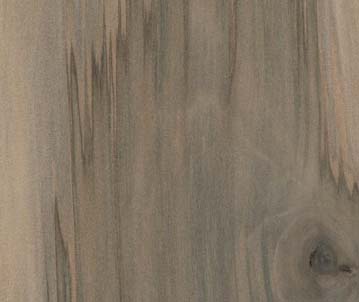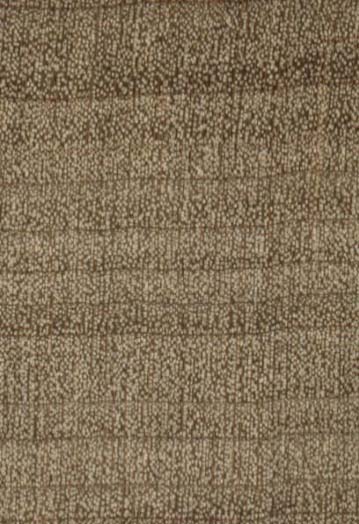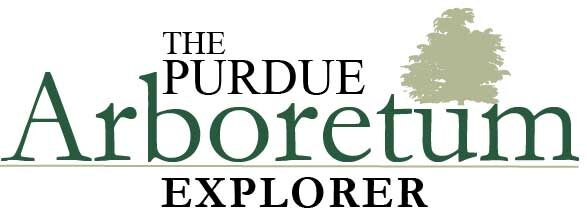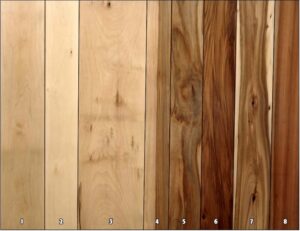Liquidambar styraciflua
Summary
Sweetgum is a relatively hard, uniform grained wood previously used for furniture and plywood. It tends to warp and stain easily. It is low valued and currently rarely used, except for industrial blocking and pallets. Today, the species usually has a wide sapwood, but some trees and particularly old trees, have a large dark heartwood.
Board 2 is all white sapwood with a few small pin knots. Boards 1 and 3 are also all sapwood, but they are probably darker or flesh colored due to oxidation stain. The center of Board 3 shows two light sticker marks across the width due to stain associated with drying stickers. These two boards are probably more typical of today’s lumber.
Boards 4, 5, and 7 are narrower boards from younger trees and show characteristic reddish, brown often streaked heartwood. Boards 6 and 8 are from old growth mature trees.
Board 6 is all heartwood with a variegated pattern.
Board 8 is nearly quartered sawn, has a uniform grain pattern and a light reddish color. Old growth sweet gum stock was sorted by several different color and sawing patterns. It was commonly used in the early- to mid-1900s as moulding and doors in houses. Pieces such as this one are sometimes mistaken for cherry.
History
Sweetgum (Liquidambar styraciflua L.) is normally thought of as a southern tree. In the north, it is noted for a brilliant red color in the fall, peculiar star-shaped leaf and numerous “gum balls” that contain the seeds but need to be raked up in ornamental settings. The twigs can also have corky out growths.
The species ranges from coastal New York to central Florida through east Texas and north to southern Illinois, Indiana, and Ohio, with the exception of the Appalachian Mountains. The tree is adaptable to a wide range of sites, but it grows best on rich, moist alluvial bottomland soils. The tree is capable of rapid growth in dense stands producing large volumes of wood. The largest tree reported is nearly 7½ feet in diameter at 4½ feet above the ground.
Color & Texture

This wood has various shades of reddish brown and can be variegated. The wood has interlocked grain, and when quartersawn, produces a ribbon stripe. Most of the sweetgum lumber produced today is sapwood with some heartwood mixed in it. This sapwood lumber normally has a pinkish or flesh color, and it can also be discolored by blue stain fungi. Sweetgum is a very fine, uniform textured wood with the pores and growth rings inconspicuous to the naked eye. The wood rays are also indistinct.
Anatomical and Microscopy

Specific Gravity (Basic, 12% MC): .46~.55; Porosity: diffuse-porous; Arrangement: small pores in no specific arrangement, very numerous; Vessels: exclusively solitary and/or in radial multiples of 2-3; tyloses common; Growth rings indistinct rays not visible without lens parenchyma not visible with hand lens
Wood Properties
- Workability
- Sweetgum is an intermediate weight wood with a uniform texture, it averages intermediate in planing, shaping, boring, and turning.
- Strength
- At 12 percent moisture content, sweetgum weighs 36 pounds per cubic foot, making it an intermediate weight wood. Its strength properties are likewise intermediate.
- Steam Bending
- Rated intermediate as an acceptable wood for bending when steamed.
- Drying
- The sapwood of sweetgum has a high initial moisture content; the heartwood is considerably lower. The wood can be dried with relatively severe kiln schedules. However, with its interlocked grain, it tends to warp severely.
- Shrinkage
- Sweetgum is an intermediate weight wood, but it has a high shrinkage coefficient equivalent to red oak.
- Decay
- The wood has no resistance to decay, and the sapwood is easily discolored by blue stain fungi.
Products
Old-growth red gum was prized and used for furniture, electronic cabinetry, millwork, doors, and paneling where a decorative effect was desired. Before the advent of reconstituted wood products, the wood was frequently used as core stock, and the flat surfaces were veneered. The wood is easily rotary cut into veneer and used in baskets and plywood core. Framestock, pallets, boxes, crates, railroad ties, and pulp are all uses for lower grade stock.

